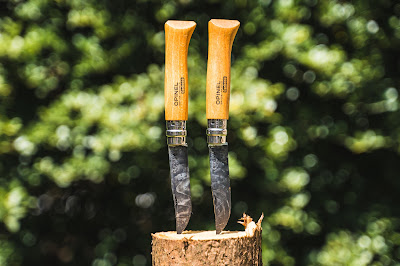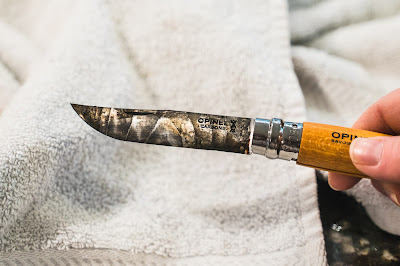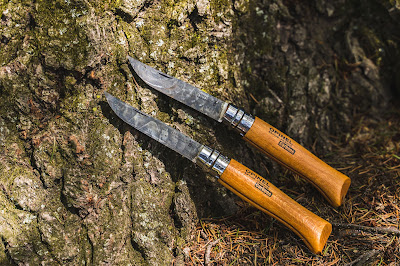by Igor
Folks typically associate patina with years of use, visible wear, and long-term care. There is an aura of warmth and satisfaction when you see a beautifully patina'd Leica, lock-up bike, vintage car, tool chest, or leather bag. Adrian found a fun article describing different ways to patina Opinel carbon steel and so we had to try it out. Some techniques involved chemicals and such, but we decided on a more natural method - stabbin' onions.
VO has been carrying Opinel knives for several years now. They're popular for their affordability, simplicity, and storied history as the go-to for French farmers, backpackers, and foragers. The carbon blade option does require more care and sharpening than their stainless steel offering, but carbon can take an edge easier. And because carbon is uncoated, they develop a nice patina over time. From Opinel: "Patina is completely normal and will help aid rust resistance of your carbon blade."
Here's what you need to create a beautiful patina on your carbon blade Opinel without years of use:
- Opinel knife
- Onion - white or red will do (we found no discernible difference in our test). Keep in mind you will be disposing of the onion once this process is done, so don't expect to use it in your next French Onion Soup or sandwich.
- Water
- Towel
- 48 hours
Literally, stab the onion in the middle - all the way down the lock. We tried orienting the blade horizontally and vertically with respect to the layers of the onion and found inserting parallel to the root produced a circular pattern, while perpendicular was more wavy. Each of them is very cool.
Now, the hard part. Put it down somewhere safe and where someone won't ask, "Why is there a knife in this onion?" Now leave it alone. The original recipe called for 24 hours, but we forgot and did 48 hours.
When the prescribed time has elapsed, pull the knife out. I will warn you, the knife will smell like onion. If you lived in an onion for 48 hours, you'd smell like an onion, too. But trust me, rinse it off with plain water and wipe it down. The smell will dissipate over the next day or so.
Behold your newly patina'd Opinel!
After doing this experiment, Adrian found some more articles about creating patina on Opinels. My favorite was simply drizzling McDonalds spicy mustard sauce over the blade and letting it sit for a bit.
I'm thinking about how to patina the Blue Lug Brass Spacers. Any ideas?








I've force oxidized using mustard in the past, it can give a smoother finish. My favorite however was using beer and a heat lamp to give a brown patina to carbon steel. Apparently you can do the same using the urin of "strong working men."
ReplyDeleteI've found a reliable way to add a patina to raw brass is to aerate with white vinegar. I've done this with brass bicycle parts, bells, headbadges, brass lighter cases. It's great because vinegar is safe to work with, cheap and available almost everywhere.
ReplyDeleteFor the brass spacers I'd do this:
• Find a plastic soup takeout container
• Pour in a tablespoon of white vinegar (you don't need much)
• Punch a hole in the lid of the container
• Tie the spacers up with string or a twist tie
• Thread your tie through the lid
• Place the lid loosely on the container
• Now your spacers will be suspended over the vinegar
The brass will darken pretty quickly (under an hour). You can control the depth of patination with the amount of exposure time. If you leave it long enough some verdigris (like the Statue of Liberty) patina will form but it usually flakes off.
You don't want to brush the vinegar on the brass or submerge the brass bits in vinegar. It's the fumes from the vinegar and aeration that does it.
If you want to age a part that isn't easy to tie up just set a small piece of "furniture" in the container and place your part on top. A block of wood works well. Limiting the surface area between the furniture and your part is helpful as any areas not exposed to the vapor will not darken.
Onion Damascus. Brilliant!
ReplyDelete